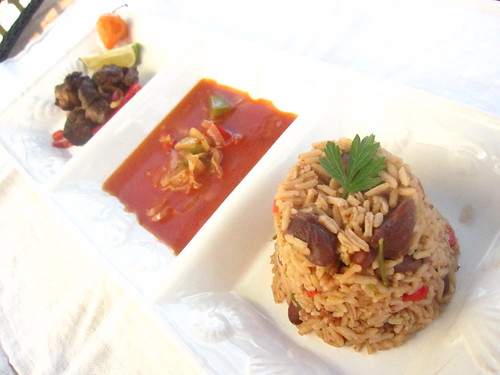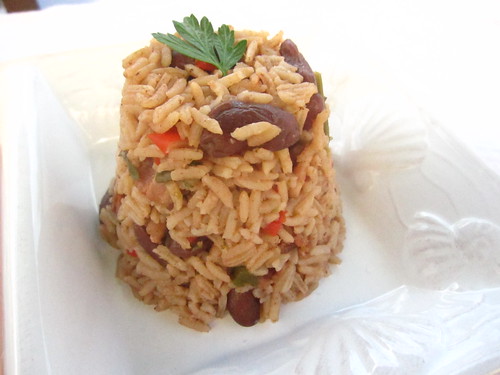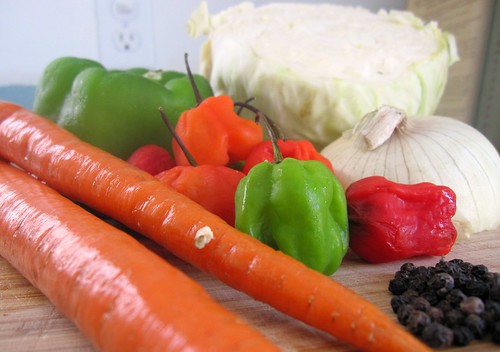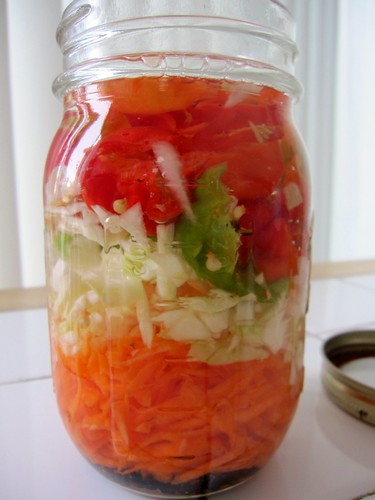
“Griyo is madd good. If you have neva tasted it, you are missing a lot.”
So much of what we think we know of Haiti is bad – from the massive human suffering and destruction caused by January’s earthquake, to decades of political and social unrest, to blood-curdling tales of voodoo curses and zombies – that one might be forgiven for wondering how the inhabitants of such a benighted country make it through the day. Perhaps surprisingly, it’s often the case that where there is the greatest suffering, there is also the most joyous celebration – think the wildly over the top bedazzled costumes and deafening samba baterias coming out of the most ravaged Rio slum at Carneval – and so it is in Haiti, and nothing says celebration to a Haitian like griyot.
Grillot/griyo/griyot/griot (pronounced gree-oh) and its accompaniments of sauce ti malice (sos ti malice) and rice and beans constitute one of Haiti’s handful of national dishes, and no Haitian party can be considered a real knees-up without it. This is particularly so on January 1, Haiti’s National Day, recalling the country’s 1804 declaration of independence from France and its arrival on the international scene as the first independent nation in the Caribbean and Latin America, as well as the world’s first black republic, and from whence it took the lead among non-English speaking nations of the western hemisphere in promulgating ideas of liberty and equality. This early split from the colonial power and the country’s several subsequent lapses in to chaos have allowed Haitian culture and cuisine to preserve its African heritage and develop in its own distinct way, largely undiluted by external influences. Ways of which we were almost completely ignorant until we ate our first meal at Kombit – a Haitian restaurant we were lucky enough to have in our neighborhood
We quickly became regulars at Kombit, the sheer novelty of having a Haitian eatery close by (not to mention the raft of delicious and completely unknown dishes) took a long while to wear off. Possibly due to the fact that we were consistently among the few non-Haitian diners, or perhaps because we always asked stupid questions about their food, owners Pascale and Marie began to recognize us, and, eventually, took rather a shine to us two inquisitive but entirely ignorant enthusiasts. Each time we visited they would patiently and smilingly respond to our inane inquiries without ever really revealing much about how the dishes we were enjoying griyot, sauce ti malice or their unbelievably special rice and beans, were made.
Ever since that first experience some six or more years ago, we’ve wanted to try to home-make griyot, and after recently getting our hands on one of two Haitian cook books in print in the United States, we reserved most of a weekend and set to work. The weekend reservation was necessary because – like many flavorful and traditional dishes, preparation ahead of time and patience are necessary – griyot is, as you’ll see if you scroll down, one of several dishes that are dependent on each other, and, if you’re not Haitian and, therefore likely to have some of these staples already hanging around, you have make them in a certain order.
Starting with the griyot – a very rustic and filling dish of marinaded, then braised, then fried pork chunks – you must be prepared to wait at least 24 hours after starting the preparation to eat it, but it is well worth the wait. The texture of it, crispy on the outside and soft inside, combined with the myriad tropical flavors filling your mouth, is quite something in itself, but when paired with its natural partner of rice and beans, it transcends its rusticity to become a truly world-class dish. In complete honesty, Haitian rice and beans are, by a margin, the best I have ever eaten. Smoky, savory and satisfying, these rice and beans are so freaking good that you would be perfectly happy to have a plate, by itself, for dinner. Every night.
We wrote way back in the spring about the Burmese national dish, Own-o Kow Swear, and noted that condiments played a crucial role in that country’s cooking. So it is in Haiti, except that there are far fewer condiments, and the few they have, are used with the same regularity as ketchup in America or olive oil in Greece. Rather handily, both of the two principal Haitian condiments, piklis and sos ti malice, work magnificently with griyot, though since the former is a fiery concoction of scotch bonnet peppers, allspice and vinegar, one should demonstrate restraint in its use in order to avoid the obvious pitfalls.
It sounds anything but appetizing, but sos ti malice – a reddish-brown, thinnish gravy, scattered with a few bits of onion and pepper – is served by the bowlful at Kombit, and we almost always have to order extra it is so good. They serve it with all sorts of dishes, but it is most appropriate with griyot because (although Pascale and Marie never revealed this to us) both the marinade and cooking juices from the griyot are used in its preparation, giving it an incredible complexity and satisfying savoriness.
Please don’t be intimidated by the length of preparation time, the seemingly exotic ingredients or the long list of recipes below. All are very easy to make, the ingredients are fairly easy to find even in an average supermarket, and most of the time you can put your feet up or do something else entirely. Out of the 24 hour (36 hour for piklis) preparation time, you’ll probably be only actively cooking for around 3 hours at the absolute most.
So, for your next celebration meal, consider making griyot and its associated dishes. They really are almost indescribably good and after eating them you’ll certainly be thinking about Haiti in a whole new light.
Ingredients
- 2-3lb bone-in pork shoulder (or 1.5-2lb boned shoulder)
- 6 cloves garlic
- 1/2 bunch scallions/spring onions
- handful of cilantro or parsley leaves
- 1 scotch bonnet pepper
- 1 teaspoon dried thyme
- 1 tablespoon brown sugar
- 1 teaspoon ground allspice
- 1/2 teaspoon ground nutmeg
- 1/2 teaspoon ground cloves
- 1 tablespoon kosher or sea salt
- 4 tablespoons piklis vinegar (see recipe below)
- 2 tablespoons olive oil
- 6 tablespoons vegetable oil
Recipe
- In a blender (or food processor), combine garlic, scallions, oil, spices, sugar, salt, herbs and vinegar until well combined. This is your marinade
- Cut pork shoulder into bite-size chunks making sure to retain some of the fat on them.
- In a large bowl, place pork chunks with marinade and, using a spoon (unless you’re wearing gloves to protect you from the scotch bonnet pepper), make sure all the meat is nicely coated. Cover with plastic wrap and allow to marinade overnight or for a minimum of 6 hours.
- The following day, in a large sauce pan, bring the meat and marinade mixture to a boil and then simmer gently for about 40 minutes.
- Drain meat pieces but reserve marinade/liquid (you’ll need this for the sauce/sos ti malice – recipe below).
- Allow meat to cool.
- In a large, heavy-bottomed pan, heat vegetable oil to medium, and shallow-fry the pork in batches until dark brown and crispy all over.
- Reserve cooking fat and drippings for sauce ti malice
- You’re now ready to enjoy griyot with your rice and beans, sauce ti malice and piklis (recipes all below). Wash down with plenty of beer as you would at any celebration!
Haitian Rice and Beans (serves 4+)
Ingredients
- 1lb dried red kidney beans (you must use dried beans for this recipe, canned will not work)
- 1lb long grain rice
- plenty of cold water
- Several large sprigs parsley
- 1/2 onion, finely diced
- 3 cloves garlic, finely chopped
- 1/2 red bell pepper, julienned
- 4oz smoked bacon
- 2 tablespoons olive oil
- kosher or sea salt to taste
Recipe
- Soak beans in abundant cold water overnight, but no longer than 12 hours
- Drain beans, and in a large pot, bring beans to a boil and simmer until tender, 20-30 minutes
- Drain cooked beans but you must keep the reddish-hued cooking liquid!(see step 7)
- Put reserved beans in a bowl for later
- Heat another large pot over medium and add olive oil. Cook bacon so it renders its smoky goodness.
- Add onions and red pepper. Saute until onion is translucent. Add garlic. Cook another 2 minutes.
- Add rice and toast it in fat and aromatics for a couple of minutes.
- Drop in parsley, and add all reserved bean cooking water and enough additional water so rice is covered to the width of two fingers (about an inch)
- Cover and bring to a boil. Boil for 10 minutes.
- Reduce heat to low for 10 minutes. Do not lift lid.
- Turn heat off and allow to steam for a further 10 minutes. Do not lift the lid.
- Stir in beans and taste for seasoning. You now have Haitian rice and beans! And it is amazingly delicious!
Sauce (Sos) ti Malice (serves 4)
Ingredients
- 1/2 onion slice thinly
- 1/2 red or green bell pepper, julienned
- 2 cloved garlic, crushed and minced
- 3 teaspoons tomato paste
- 4 tablespoons cooked and reserved griyot marinade/juices
- reserved griyot frying juices
- 1 tablespoon olive oil
- 1 tablespoon piklis vinegar (optional)
- 1 cup chicken, pork, beef or vegetable stock (or water)
Recipe
- In a saute pan over medium heat, saute onions and bell pepper, until nicely softened. Add garlic.
- Saute for another couple of minutes before making a hot spot and gently toasting the tomato paste until slightly browned.
- Add reserved griyot marinade and cooking juices and stir well.
- Add enough stock (or water) to thin sauce to a light gravy consistency.
- Add piklis vinegar (optional) and taste for seasoning. Should taste delicious!
- This is your sauce ti malice. Serve in a bowl on the side of griyot and rice and beans.
Haitian Piklis/Piklese
Ingredients
- 6-10 scotch bonnet peppers, cut into rings (take precautions handling these peppers. I use a knife and fork, but disposable gloves also work.)
- 1 large carrot grated
- 1/4 white or green cabbage, grated
- 1/2 green bell pepper julienned
- 1-1.5 pints (1/2 – 3/4 liter) white vinegar
- 10 black peppercorns
- 6 allspice berries
Recipe
- In a large jar or other sealable container, combine all ingredients and stir well.
- Allow to steep for at least 36 hours before use, best after about a week.
- Enjoy with all Haitian foods, but it’s especially good cutting through the richness of griyot.
- Note: you can add more carrot or cabbage (and peppers) and vinegar to the piklis as you use it, so it becomes kind of a living thing, with slightly different ratios of vegetables and sometimes more or less spicy than others. Store in refrigerator.





Fabulous dish. Good of you to remind us that there is much more to Haiti than voodoo and suffering. The spicy island spirit is alive and well in their cuisine
That malice salsa looks awesome. It reminds me of chow chow picalilly, but way, way spicier. This shit would terrify the fuck outta some Amish people.
(Sorry, I meant the piklis, not the sauce.)
Earlier this year when i did the virtual Culinary Tour Around the World one of the ‘stops’ was Haiti and I really enjoyed the food. A lot of Haitians live in So FL and I find them to be lovely people.
Your photos in this post are really beautiful!
@Deana – right on!
@Heaher – piklis is some serious business, and it does a number on (y)our intestines, but it’s frickin’ awesome!
@Joan – isn’t it fascinating how places that we normally associate with poverty and hunger, actually have awesome food – like Ethiopian food, for example?
This looks really good. And that piklis is the perfect thing for me to use all of these scotch bonnets we have finishing up in the garden. I have a feeling that will make an amazing condiment to my next burger.
Wow! Everything is so lovely and very delicious looking. I would love to try them all.
Can’t wait to try the fried pork. It looks very similar to a a fried pork recipe that we make here in Trinidad.
Is there a step #4 for preparing the Sauce (Sos) ti Malice?
@Josh – oops, sorry about that. Just a coding error (now fixed). There are no extra steps. Thanks for catching the mistake!
In 1994, I was a medic assigned to the 10th Mountain Division. President Clinton decided the US should restore Haiti’s democratically elected President (at least that’s the official version), so we went in to boot Cedras out and welcome Aristide back. I had some very plain versions of griyot sold by street vendors in Port au Prince, nothing to write home about. Then we got sent out to Jeremie for a week. One evening the commander went out on patrol with 1st platoon, and there were rumors of a woman selling food a few blocks from camp, so a large portion of those not on patrol with the commander jumped the wall to get some real food. While my buddy and I are standing in line waiting our turn, the woman ran out of supplies and had to go get more. About that time a little girl, about 9 years old, tugged on my sleeve and said “Mistah, you want manje?” We said yes, please, and followed her off into the city. She led us a couple of miles through some of the darkest, most run-down neighborhoods and we were starting to get more than a little worried when we came to a wider and wealthier looking street. We saw a small building with a table and awning out front with a few fat men (you didn’t see many fat men in Haiti) sitting out front smoking cigars. The men nodded to us and the little girl ushered us inside. Inside was another fat man, nicely dressed, sitting at a large table drinking icewater; obviously someone important. He gestured for us to sit. We did and were soon brought an ice cold Guiness each, followed soon by griyot, plantains, rice & beans, piklis, and what we thought was a really good spicy red soup. NOW, thanks to you, I know that was NOT soup and understand what the girl was trying to tell us. I thank God for sending us that little girl and pray she grew up safe and has a decent life. She shared her culture with us. I believe food is the best language for sharing culture; it requires no translation, just an open mind and a willing pallet.
I thank you for sharing these recipes. I cooked it all up and it really brought back some strong memories, even though this version is more sophisticated than what we had back then.
@Wheeler: thank you so much for this comment and story. We love it when we people tell us what the food means to them and what memories it evokes. There are few things more powerful in evoking memories than a taste or a smell, and we agree 100% that food is the best language for sharing culture. We had no prior knowledge about haiti or its food, but after that first experience of wandering into that restaurant, we were hooked and it encouraged us to return time and again and learn more about that fascinating country and it’s troubled history. By the way, I can totally see how sos ti malice could be a great soup too!